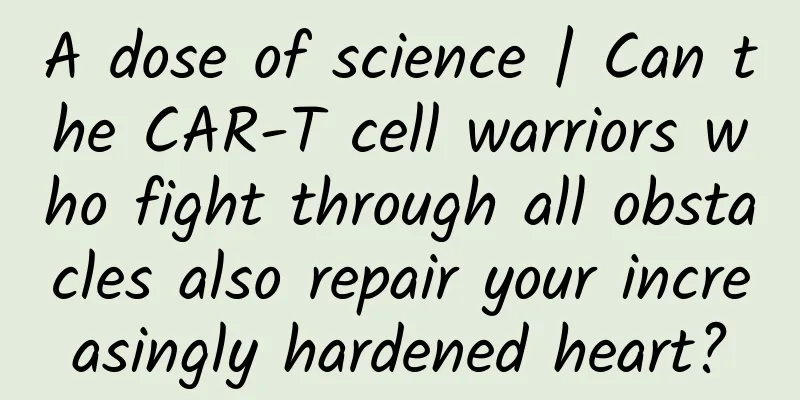A dose of science | Can the CAR-T cell warriors who fight through all obstacles also repair your increasingly hardened heart?

|
In a cutting-edge cancer treatment called CAR-T cell therapy, some of a patient's immune cells are extracted and engineered to express a "CAR" receptor that enables the cells to lock onto and destroy cancer cells. Using a new method developed in mice, researchers can now make CAR-T cells in vivo without having to extract and re-infuse the cells, and then use them to treat a completely different disease than cancer. In mice, the resulting CAR-T cells targeted a type of wound-healing cell called fibroblasts, thereby reducing the formation of cardiac scar tissue. The relevant paper results were published in the journal Science. Paper cover 01: Finding a new way Since the heart cannot regenerate lost cells, after a heart attack or other heart injury, cardiac fibroblasts form a scar that is essential for maintaining the heart's structure and its ability to pump blood. However, excessive fibrotic scarring can also make the heart stiff and affect heart function, a characteristic of most heart diseases that can lead to loss of heart function and ultimately to heart failure, the end result of heart disease that kills 800,000 people each year. Chimeric antigen receptor T cell (CAR-T) therapy is a new approach to treating cancer. Researchers extract a patient's T cells and modify them to present receptors that recognize specific complementary antigens on cancer cells. These T cells are then infused back into the patient to track down and kill cancer cells. CAR-T cells have been approved as a treatment for some leukemias and lymphomas since 2017, and many clinical trials for solid tumors are currently underway. Previous clinical applications have repeatedly proven that CAR-T cell therapy can effectively and accurately kill cancer cells Haig Aghajanian of the University of Pennsylvania thinks that if T cells can be engineered to kill certain cancer cells, they should also be able to attack the cells that cause the heart to stiffen and lose function. “If we can eliminate the fibroblasts in a stiff heart, maybe we can make the stiff heart pump better,” says Haig. Haig and Jonathan Epstein first used traditional methods to design CAR-T cells in vitro to target fibroblast activation protein (FAP), a surface antigen on activated fibroblasts. They found that in mice with heart damage, CAR-T cells successfully targeted and killed activated fibroblasts and reduced cardiac fibrosis. Schematic diagram of the experiment of FAPCAR-T cells targeting cardiac fibroblasts Coronal sections of the hearts of three groups of mice. The fibrotic part is stained red However, CAR-T cells modified in vitro can persist for months after being transferred into the patient. Wound healing requires activated fibroblasts, so "if CAR-T cells targeting fibroblasts persist, this increases the risk of future injuries," said molecular biologist Hamideh Parhiz. 02: Put away the knife at the right time In order to produce CAR-T cells that are only active for a short time in the body, Haig and Jonathan collaborated with Drew Weissman, who specializes in research on targeted delivery of nanodrugs, and used mRNA technology that has been successfully used in the new crown vaccine. The injected mRNA allowed T cells in the mice to produce their own chimeric antigen receptors (CARs) that targeted FAP on fibroblasts. Similar to the mRNA-based COVID-19 vaccine, the mRNA was encapsulated in lipid nanoparticles. The researchers targeted these nanoparticles to T cells by modifying them with antibodies against CD5, a receptor naturally expressed by T cells. T cells absorb the mRNA and translate it into FAPCAR, but because mRNA is not stable, this production of FAPCAR is only temporary. "About 24 to 48 hours after (lipid nanoparticle) injection, we could find 15% to 22% of FAPCAR-positive T cells in the mice... Then the level gradually decreased, and one week after the injection, no expression of the FAPCAR receptor could be found." To test how well the CAR-T cells produced in vivo work, the researchers injected mice with angiotensin II and phenylephrine to induce hypertension. One week after fibrosis developed, the team injected the mice with lipid nanoparticles containing mRNA. The mice were evaluated by echocardiography two weeks later, and their heart function improved compared with control mice that had cardiac fibrosis but were not treated with CAR-T cells. The researchers looked at the heart tissue of the mice and found that scar tissue in the ventricles was reduced, and the CAR-T treatment group was almost indistinguishable from the healthy control group. Only scar tissue around the blood vessels persisted because the fibroblasts that cause this vascular fibrosis do not express FAP, the target of this CAR-T cell. Mouse heart fibrosis for three weeks, and various cardiac functions were analyzed after two weeks of treatment M-mode echocardiography of mice after combination "Using this approach to target and reprogram immune cells represents an innovative application in cardiovascular medicine and opens up exciting opportunities for the development of new therapies," said Ronald Vagnozzi and Timothy McKinsey, heart researchers at the University of Colorado. 03: Application Outlook Molecular biologist Jeffery Molkentin mentioned that this method is "groundbreaking because it is a completely new way of thinking about therapeutic applications, redirecting T cells to control the number of other abnormal cells. Obviously, CAR-T technology has great significance for cancer treatment, but it is just an introduction." Hamid has founded a company to develop a platform for reprogramming immune cells, with the goal of developing existing CAR-T cell therapies—and they don’t have to be tailored for individual patients. In the long run, Hamid said, mRNA could also be used to reprogram other cell types for broader applications. For example, mRNA could be targeted to reprogram endothelial cells, which could be used to treat injuries such as acute respiratory distress syndrome, a life-threatening lung disease caused by trauma, COVID-19, and more. Regarding the use of CAR-T cells to treat heart disease, Jeffrey cautioned that "it is not clear whether mouse studies are sufficient to tell us about the long-term consequences of using FAPCAR-T in a human setting," including potential off-target effects of CAR, which may require further clinical trials. Ronald and Timothy pointed out that in this study, CAR-T cell therapy was applied early in the disease process. "It will be important to see if this approach can be used to treat hearts with severe, stable scars, or other heart diseases where fibrosis may have persisted for years before treatment." They noted that one of the questions is how specifically removing fibroblasts from the heart will change scar tissue and heart function, because "subtle changes in the extracellular matrix can also have a significant impact on how the heart contracts and relaxes. However, Jeffrey stressed that this approach must be "first of its kind" in that it allows for temporary treatment using CAR-T cells. "For a short period of time, it will still work like a drug. The effects it produces will not be irreversible, but it can be used multiple times." It is foreseeable that after the "pruning" of this CAR-T technology, combined with the regeneration of myocardial cells by stem cells, it may have great medical value in treating heart disease. In any case, at least the impact of this "immune revolution" involving CAR-T cell technology is likely to exceed oncology and affect one of the diseases with the highest morbidity and mortality in humans - heart disease, which is enough to shake the pattern of medical treatment. References: [1] Rurik JG, Tombácz I, Yadegari A, et al. CAR T cells produced in vivo to treat cardiac injury[J]. Science, 2022, 375(6576): 91-96. [2] Aghajanian H, Kimura T, Rurik JG, et al. Targeting cardiac fibrosis with engineered T cells[J]. Nature, 2019, 573(7774): 430-433. [3] Ghosh AK, Chen DH, Guha A, et al. CAR T cell therapy–related cardiovascular outcomes and management: systemic disease or direct cardiotoxicity?[J]. JACC: CardioOncology, 2020, 2(1): 97-109. Layout: Original Energy Cell-EAIS Compiled by: Original Energy Cell-EAIS Producer: Julie from Primal Cell |
>>: Why does my child keep blinking?
Recommend
The best treatment for uterine polyps
With the continuous development of social and eco...
Pain in the vagina after intercourse
Under normal circumstances, there will be no vagi...
Is Guobao Rou sweet or salty? How to make the sauce for Guobao Rou
The appearance of sweet and sour pork is red and ...
How to abort a pregnancy within 20 days
It is impossible to accurately determine whether ...
Can I get pregnant if my discharge is yellow?
As we all know, women's vaginas often have so...
New Year’s Day is coming. Learn about the current development trends of epidemics in our country in this article to protect your health during the holidays!
The New Year's Day holiday is coming, but win...
What are the functions and benefits of Maojian? Why is Maojian bitter?
The main ingredients of Xinyang Maojian tea are a...
Health Science: Beware of allergic rhinitis!
Every year when the seasons change, especially af...
What Chinese medicine should women take for spleen deficiency
For women, skin care is a daily necessity. Every ...
The most obvious signs of pregnancy
In the early stages of pregnancy, the symptoms ar...
What is the largest turtle in the world? What type of animal is a turtle?
The turtle (scientific name: Mauremys reevesii) i...
It's very loose down there. How can I recover?
It is very common for women to experience sagging...
Pregnant women dream of eating fish
What does it mean when a pregnant woman dreams of...
What are the ways to get rid of stretch marks?
I believe that many mothers who have given birth ...
Pregnant women are prone to misdiagnosis of hepatitis C. Learn to do this
Nowadays, many pregnant women may be misdiagnosed...









